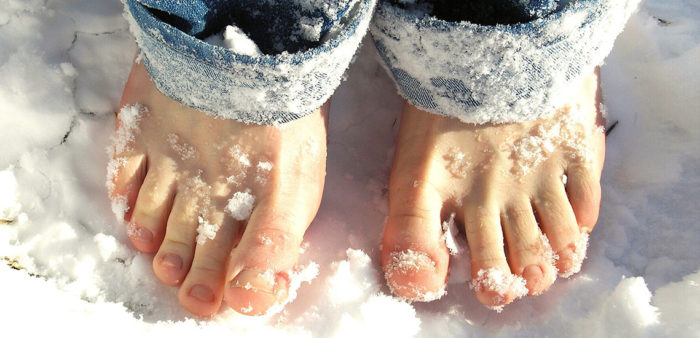Why Your Feet Get Cold in Winter and What You Can Do
4th December 2016
Cold feet during winter months is a relatively normal thing. In fact, most people experience a bit of cold when they’re out and about on snowy days. But when your feet start feeling uncomfortably chilly or even painful, then it’s high time you reconsider your footwear choices or even pay a visit to the doctor’s office. There are many reasons why our feet may feel cold during cold weather, ranging from genetics, medical conditions, to low-quality footwear. In this article, we cover everything there is to know about cold feet from a scientific and medical viewpoint, and we also offer bits of advice on how to keep your feet warm once and for all. In combination with shoes and socks our Zederna cedarwood inserts will be a very good solution to get rid of cold feet in winter.

What Causes Cold Feet And Why Your Feet Need Special Attention
Your feet and hands are where you sweat more than anywhere else on your body. Sweating is essentially a natural process. When your body overheats, blood vessels on the surface of your skin constrict and sweat glands are activated helping your body cool down. Sweating is most noticeable in your armpit area but also on your palms and foot soles. Your hands and feet also react strongly to cold temperatures. Exposure to cold results in our bodies redirecting blood flow to internal organs and away from the hands and feet. Since our feet (and hands) are the sweatiest and at the same time, the coldest parts of our bodies, this means that keeping them warm and dry during cold weather is particularly challenging.
Other Factors That Lead To Cold Feet
If, however, your feet are cold no matter what the ambient temperature is, then this is most likely due to intrinsic factors. An article published in Podantics.com.au states that on the whole, cold feet are a result of cold temperatures and the resulting constricting of blood vessels and reduced blood flow. Women are affected more often than men, partly due to hormonal factors, but also as an evolutionary mechanism where the body tries to keep the core body temperature even in order to protect the fetus. In addition to this, certain medical disorders affecting circulation or the nerves can also lead to cold feet. Disorders associated with cold feet are anemia, thyroid problems, Raynaud’s disease, hypertension, lupus, rheumatoid arthritis, and poor circulation.
“Keeping your feet dry and warm is extremely important”
Cold Feet And The Role Of Footwear
Researchers have been studying the properties of footwear and their effects on our feet for quite some time now. This is especially true for winter footwear as the type of shoe you wear in extreme weather conditions can affect your health and even your survival. Take for instance a study that was published in the British Journal of Sports Medicine which found that, after the hands, the feet were most commonly affected by frostbite in mountaineers. Not surprising is the fact that 56% of those affected with frostbite claimed to not have had the appropriate equipment with them at the time, including proper boots. From what we can conclude, keeping your feet dry and warm is extremely important because feet are naturally susceptible to frostbite. Wearing proper footwear is one way to do so. And complementing your boots with an additional insulating layer such as ZEDERNA Cedar Soles can add to the positive effects of proper footwear to fight cold feet. Cedar Wood Shoe insoles have a strong ability to absorb sweat and excess moisture, which keeps your feet dry and comfortably warm.
“Complementing your boots with an additional insulating layer such as ZEDERNA Cedar Soles can add to the positive effects.”
Insulation And Clammy Feet
Winter shoes need to be both waterproof and breathable. Creating such a shoe is challenging which is why shoe-making is a science in its own right. Leaky shoes inevitably lead to freezing feet. On the other hand, too good of an insulation can prevent sweat from escaping which creates a moist environment inside the shoe. Whichever way you turn it, the problem always seems to be with water and humidity. The reason for this is that water has strong thermal conductivity, meaning that it lets heat escape. On the other hand, air has poor heat conductivity and as such, traps heat and helps it circulate. This phenomenon is carefully explained in in a research article published in the Journal of Physiological Anthropology.
The Anatomy Of The Perfect Shoe
If you’ve suffered from cold feet winter after winter, you’ve probably tried tackling this problem by wearing thicker shoes and socks. However, you might actually be making problems even worse in this way. Instead, you’d be better off with good-fitting shoes consisting of two or three layers and accompanying winter socks. The previously mentioned research article from the Journal of Physiological Anthropology actually found that even the thickest and heaviest winter boots tend to lose their insulating properties because they tend to trap sweat. Although adding a pair ZEDERNA Cedar Soles could help to deal with excess moisture, try sticking to lightweight boots. Also, make sure to choose winter shoes made of breathable upper materials such as leather, and combine this with wearing woolen socks. Also, thick soles are a must as they help keeping your feet off the cold ground, and wearing ZEDERNA Cedar Wood Insoles will get you an additional insulating layer into your boots.
Why Choose Wool To Prevent Cold Feet
Wool socks and wool insulation, in general, is the best material you could be wearing during winter. Wool’s tendency to crimp creates air pockets in between individual wool fibers. These air pockets help trap your body’s heat and keep it there. Furthermore, wool is the only fiber that insulates even when wet. Wool fibers have cuticle scales that repel water from getting into wool’s tiny air pockets. At the same time, water vapor is absorbed into the cortex of each fiber and a small amount of heat is generated in this process known as “heat of sorption” adding warmth in even damp conditions. So, if your feet get cold easily, wearing wool socks, shoes with wool insulation, and ZEDERNA Cedar Soles may be just what you need. However, the type of shoe you will wear depends on where you’re heading – to the mountain, the park, to your office, or for a stroll around the street.

Conclusion
If your feet have the tendency to get cold during the cold winter weather, then the problem may lie in your shoes and even your socks. In addition to that, some medical conditions may be affecting your circulation and peripheral nerves, which may also lead to feelings of coldness. Whatever the reason may be, quality shoes, socks, and inserts like the cedar wood shoe insoles by ZEDERNA can help tackle this common problem. And keep in mind, to enjoy your winter strolls it is essential to protect your feet from excessive moisture and heat loss.
Why not head over to our ONLINE SHOP and order your warming pair of ZEDERNA Cedar Wood Insoles today!


